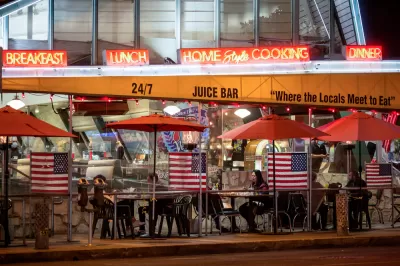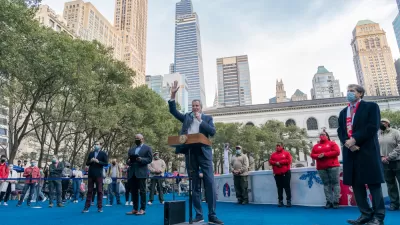The Los Angeles County Board of Supervisors recently closed outdoor dining because of a sudden but rapid rise of coronavirus infections in the county.

After the L.A. County Department of Health's order to shut down outdoor on-site dining facilities, restaurant owners and other food service workers want to know why their service is under fire while retail and gyms are allowed to stay open at a reduced capacity.
What data did the county Board of Supervisors consult when making this decision? Farley Elliott says that Los Angeles County, despite having a "fairly robust" contract-tracing program, has gathered data that are far from exhaustive and clean. The County has faced great difficulty in tracking cases with "10 million inhabitants, 31,000 restaurants, few mechanisms currently in place to limit individual travel, and no mandate to collect customer data at restaurants or points of retail," writes Elliott.
According to county officials, it is estimated that up to 15% of COVID cases can be traced to "dining experience," Elliott reports. UCLA associate professor of community health sciences and epidemiology Shira Shafir indicates that according to the contact tracking data, outdoor dining could contribute to the spread of the virus. Officials point to risk in any activity that requires people to gather, and especially those that require the removal of face coverings.
Elliot says that the county Board of Supervisors' decision to close outdoor dining has nothing to do with the causal data connecting specific activities to the spread of the virus. "Simply put, county officials agreed to shut down outdoor dining because coronavirus cases and hospitalizations have been rising dramatically over several weeks, and reducing the number of places where people gather — especially unmasked — is one of the levers of power available to them," opines Elliot.
FULL STORY: Where Is the Data to Support Closing Outdoor Dining in LA? It’s Complicated

Alabama: Trump Terminates Settlements for Black Communities Harmed By Raw Sewage
Trump deemed the landmark civil rights agreement “illegal DEI and environmental justice policy.”

Planetizen Federal Action Tracker
A weekly monitor of how Trump’s orders and actions are impacting planners and planning in America.

Why Should We Subsidize Public Transportation?
Many public transit agencies face financial stress due to rising costs, declining fare revenue, and declining subsidies. Transit advocates must provide a strong business case for increasing public transit funding.

Understanding Road Diets
An explainer from Momentum highlights the advantages of reducing vehicle lanes in favor of more bike, transit, and pedestrian infrastructure.

New California Law Regulates Warehouse Pollution
A new law tightens building and emissions regulations for large distribution warehouses to mitigate air pollution and traffic in surrounding communities.

Phoenix Announces Opening Date for Light Rail Extension
The South Central extension will connect South Phoenix to downtown and other major hubs starting on June 7.
Urban Design for Planners 1: Software Tools
This six-course series explores essential urban design concepts using open source software and equips planners with the tools they need to participate fully in the urban design process.
Planning for Universal Design
Learn the tools for implementing Universal Design in planning regulations.
Caltrans
Smith Gee Studio
Institute for Housing and Urban Development Studies (IHS)
City of Grandview
Harvard GSD Executive Education
Toledo-Lucas County Plan Commissions
Salt Lake City
NYU Wagner Graduate School of Public Service





























